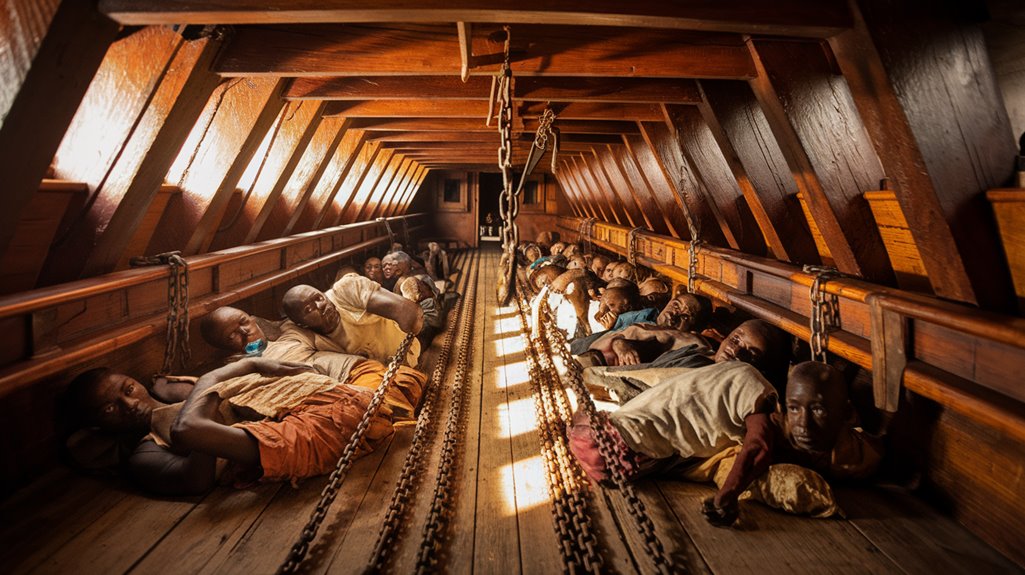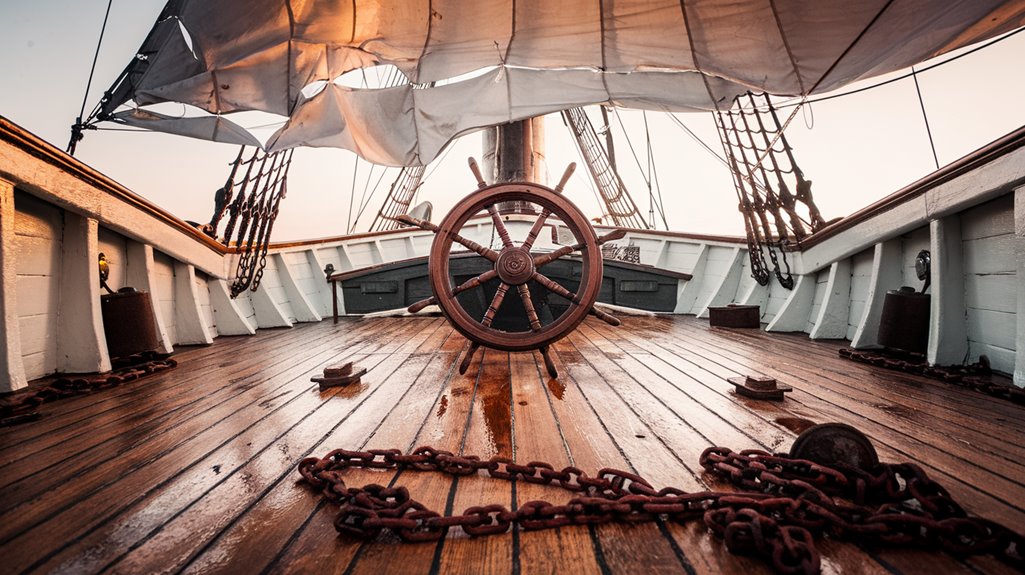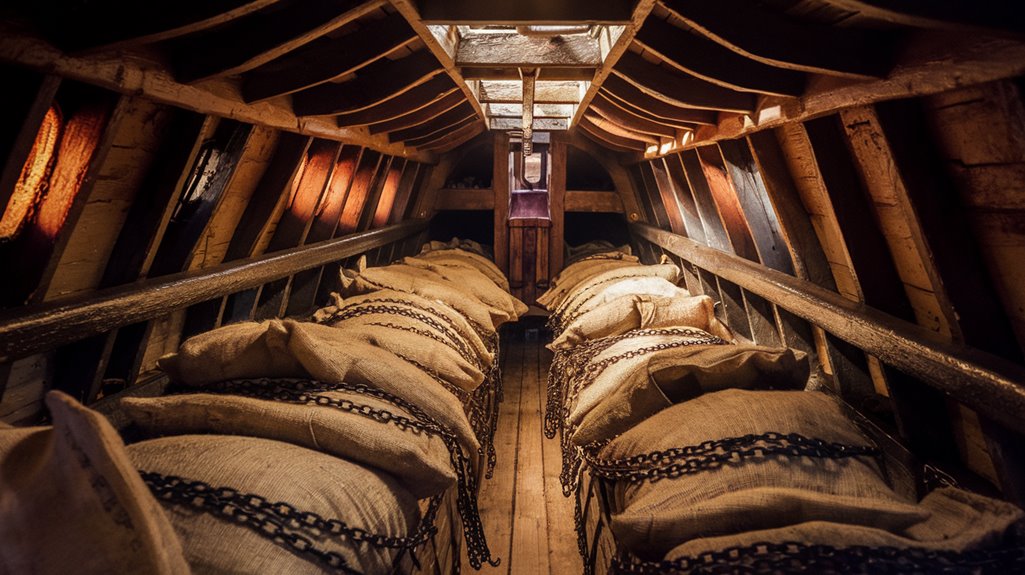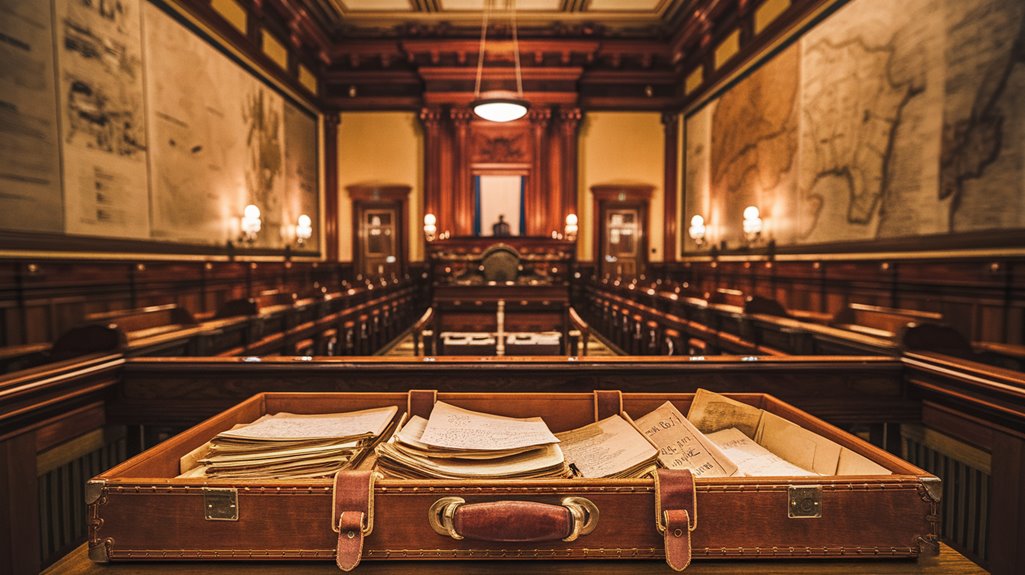The Amistad Rebellion: The Slave Ship Uprising That Changed History
Picture a moonlit night in 1839, when the clash of steel and desperate shouts shattered the Atlantic's silence aboard La Amistad. You've likely heard snippets about this famous slave ship rebellion, but there's far more to the story than a simple uprising. It's a tale that weaves together the courage of 53 captured Africans, the complexities of international law, and the growing tensions that would eventually tear America apart. What happened on that fateful night would spark a chain of events that no one could have predicted.
The Origins of La Amistad and Its Captive Passengers

While slave trading had been outlawed internationally by 1839, the schooner La Amistad became embroiled in this illegal practice when it transported 53 captured Africans from Sierra Leone's Mendeland region.
You'll find that these captives, torn from their cultural heritage, were illegally sold in Havana to Spanish plantation owners Don Jose Ruiz and Don Pedro Montez.
Their leader Sengbe Pieh, who would later become known as Joseph Cinque, had been violently captured in a surprise raid on his village earlier that year.
Unlike typical slave ships of the era, La Amistad wasn't designed for the trans-Atlantic slave trade but rather served as a domestic vessel for Cuba's coastal commerce.
The ship carried general cargo alongside its human cargo as it departed Havana on June 28, 1839, bound for Porto Principe.
The crew divided the captives between the main hold and deck, unknowingly giving them enough freedom to plan their upcoming rebellion.
During the voyage, the captives managed to kill the captain and several crew members in a desperate bid for freedom.
A Daring Revolt at Sea: Sengbe Pieh's Leadership
Under the cover of darkness, Sengbe Pieh, a rice farmer from Sierra Leone, orchestrated one of history's most remarkable slave ship rebellions.
Using his wits and determination, he managed to free himself with a loose spike before liberating his fellow captives. Sengbe Pieh's bravery became evident as he led the uprising, arming the group with cane knives from the cargo hold. The revolt involved fifty-three African captives who united against their Spanish captors.
His leadership qualities shone through as he made strategic decisions during the revolt, sparing select crew members while eliminating immediate threats. The revolt would later inspire Nathaniel Jocelyn to create a dignified portrait that became a powerful symbol of the abolitionist movement.
Though they successfully seized control of La Amistad, the journey wouldn't end there. Despite Montez's deceptive nighttime navigation and the eventual capture off Long Island, Sengbe's defiant spirit remained unbroken, earning him recognition in the New York Sun and solidifying his place in history.
The Legal Battle for Freedom in American Courts
After seizing control of La Amistad, the African captives faced an intricate legal battle that would test America's judicial system and constitutional principles.
The federal government initially argued for the return to Spain based on treaty obligations with the Spanish crown.
You'll find that multiple parties staked claims in the case: Lt. Gedney sought salvage rights, Spain demanded the return of "property," and the Africans fought for their freedom.
The case wound through various courts, wrestling with complex legal principles and jurisdiction issues.
Led by their leader Joseph Cinqué, the Africans had freed themselves using a file to break their chains before taking control of the ship.
While Connecticut courts claimed they couldn't rule on acts in Spanish waters, the federal district court declared the Africans were free men illegally captured.
When President Van Buren's administration appealed, the Supreme Court, with Justice Story presiding, ultimately ruled in the Africans' favor.
John Quincy Adams's compelling argument about natural rights helped secure their freedom and return to Africa.
The Role of Abolitionists and International Pressure
As the Amistad case unfolded, abolitionists swiftly mobilized to transform the captives' plight into a powerful symbol against slavery.
Led by Lewis Tappin, the Amistad Committee implemented new abolitionist strategies, shifting from moral persuasion to legal action. You'll find their impact was strengthened by international treaties that had already outlawed the slave trade. The case emerged during a period when Cuba imported 181,600 enslaved people from Africa despite international prohibitions.
After arriving near Long Island, the U.S. Navy seized the ship and imprisoned the surviving Africans while freeing the Spanish crew members.
Key elements that shaped this pivotal moment included:
- Former President John Quincy Adams's powerful Supreme Court defense
- British pressure on Cuba to enforce anti-slavery agreements
- The Amistad Committee's successful fundraising for legal defense
- Widespread public attention that energized the abolition movement
This convergence of abolitionist advocacy and international pressure proved vital, ultimately securing the Africans' freedom and setting a precedent that would influence future anti-slavery efforts in America.
Legacy and Impact on the Anti-Slavery Movement

The Amistad Rebellion's far-reaching effects transformed America's anti-slavery landscape well beyond the courtroom victory.
You'll find its influence reflected in how abolitionists changed their strategies, shifting from moral arguments to legal precedents when challenging slavery's legitimacy. Former president John Quincy Adams argued passionately before the Supreme Court, setting a powerful example of high-profile advocacy for the abolitionist cause. The case became powerful cultural symbolism for the anti-slavery movement, demonstrating that resistance against oppression could succeed through legal channels.
The rebellion's impact extended into organized activism, as you can see in the formation of the American Missionary Association, which grew from the committee that defended the Amistad captives. The historic revolt of 53 enslaved Africans sparked unprecedented public discourse about slavery's morality throughout the nation.
The case's legacy strengthened the abolitionist cause by exposing the horrors of the Middle Passage to the American public and establishing crucial legal groundwork for future challenges to slavery's institution in the United States.











